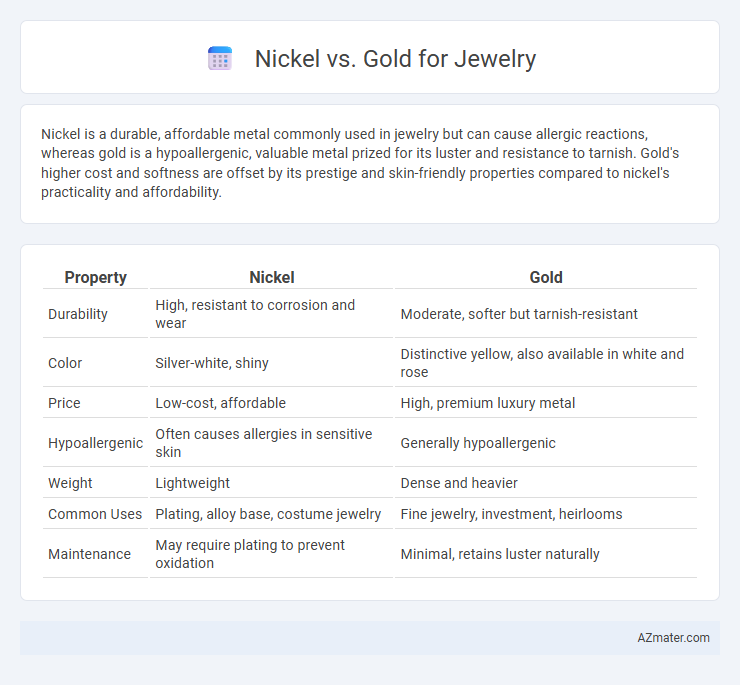Nickel is a durable, affordable metal commonly used in jewelry but can cause allergic reactions, whereas gold is a hypoallergenic, valuable metal prized for its luster and resistance to tarnish. Gold's higher cost and softness are offset by its prestige and skin-friendly properties compared to nickel's practicality and affordability.
Table of Comparison
| Property | Nickel | Gold |
|---|---|---|
| Durability | High, resistant to corrosion and wear | Moderate, softer but tarnish-resistant |
| Color | Silver-white, shiny | Distinctive yellow, also available in white and rose |
| Price | Low-cost, affordable | High, premium luxury metal |
| Hypoallergenic | Often causes allergies in sensitive skin | Generally hypoallergenic |
| Weight | Lightweight | Dense and heavier |
| Common Uses | Plating, alloy base, costume jewelry | Fine jewelry, investment, heirlooms |
| Maintenance | May require plating to prevent oxidation | Minimal, retains luster naturally |
Introduction: Nickel vs Gold in Jewelry
Nickel and gold are two distinct materials commonly used in jewelry, each with unique properties and consumer appeal. Gold is prized for its natural luster, durability, and hypoallergenic qualities, making it a preferred choice for high-end and classic jewelry pieces. Nickel, often utilized as an affordable alloy or plating metal, provides strength and resistance to corrosion but can cause allergic reactions in sensitive individuals.
Composition and Properties of Nickel and Gold
Nickel, a durable and corrosion-resistant metal, is commonly used in jewelry alloys to enhance strength and reduce costs, though it may cause allergic reactions in sensitive individuals. Gold, primarily composed of 24-karat purity, is valued for its malleability, natural resistance to tarnish, and hypoallergenic properties, making it ideal for high-quality jewelry. Comparing their elemental compositions, nickel is a silvery-white metal with atomic number 28, while gold is a dense, yellow metal with atomic number 79, highlighting their distinct physical and chemical characteristics essential for jewelry manufacturing.
Aesthetic Differences: Appearance and Color
Nickel jewelry typically displays a cooler, silver-gray tone that complements modern and minimalist aesthetics, while gold jewelry offers a warm, rich yellow or rose hue, symbolizing luxury and tradition. The reflective properties of gold create a distinctive shine and depth, enhancing intricate designs, whereas nickel's finish tends to have a more subtle, matte-like appearance that appeals to understated elegance. Over time, gold resists tarnishing and maintains its luster, whereas nickel may develop a duller patina, influencing the overall visual impact of each material in jewelry.
Durability and Wear Resistance
Nickel offers superior durability and excellent wear resistance, making it a popular choice for jewelry that endures daily use without losing its shape or strength. Gold, while softer and more prone to scratches, provides a luxurious appearance and retains its value but often requires alloying with stronger metals to enhance its wear resistance. For long-lasting jewelry, nickel's hardness and resistance to corrosion give it a practical advantage over pure gold in terms of durability.
Hypoallergenic Qualities: Skin Sensitivity Concerns
Nickel is a common allergen frequently causing skin irritation and allergic reactions in sensitive individuals, making it less suitable for hypoallergenic jewelry. Gold, especially high-karat varieties (18K and above), is much less likely to cause skin sensitivity due to its pure metal content and minimal alloy additives. Choosing gold jewelry reduces the risk of contact dermatitis and is preferred for those with metal allergies or sensitive skin prone to irritation.
Cost Comparison: Nickel vs Gold Jewelry
Nickel jewelry is significantly more affordable than gold, making it a popular choice for budget-conscious consumers. Gold prices fluctuate based on market demand and purity, often costing several times more per gram than nickel alloys. While nickel offers cost efficiency, gold's value as a precious metal adds investment potential and long-term durability.
Maintenance and Care Requirements
Nickel jewelry requires regular cleaning due to its tendency to tarnish and cause skin irritation, especially for those with metal allergies. Gold, particularly higher karat varieties, demands less frequent maintenance but still benefits from occasional polishing to maintain its luster. Both metals should be stored in dry, airtight conditions to prevent corrosion and scratches, with gold generally offering superior durability and resistance to tarnish compared to nickel.
Popular Uses and Styles in Jewelry Design
Nickel is widely used in fashion jewelry and costume pieces due to its affordability and strength, often found in allergy-resistant alloys and bold, modern designs. Gold remains the preferred choice for luxury jewelry, prized for its natural luster, durability, and versatility in traditional and contemporary styles such as classic solitaires, intricate filigree, and elegant chains. While gold is favored in fine jewelry collections and investment pieces, nickel alloys dominate in trend-driven, everyday accessories with diverse finishes, from polished silver tones to matte textures.
Environmental and Ethical Considerations
Nickel mining often involves significant environmental degradation, including habitat destruction and water pollution, raising ethical concerns about ecosystem impact and worker safety. Gold extraction typically requires toxic chemicals like cyanide and mercury, leading to contamination and harmful effects on local communities and biodiversity. Sustainable jewelry brands increasingly favor recycled gold or nickel-free alternatives to minimize ecological damage and promote ethical sourcing practices.
Making the Right Choice: Which Metal Suits You?
Choosing between nickel and gold for jewelry depends on skin sensitivity and style preferences. Nickel, often used as a base metal or alloy, is durable and affordable but can cause allergic reactions for sensitive skin. Gold offers a hypoallergenic, luxurious option with varying karat purity levels impacting its softness and price, making it ideal for those seeking elegance and long-term investment.

Infographic: Nickel vs Gold for Jewelry
 azmater.com
azmater.com